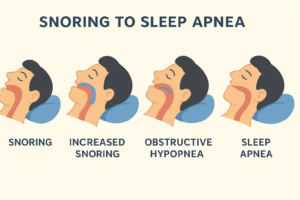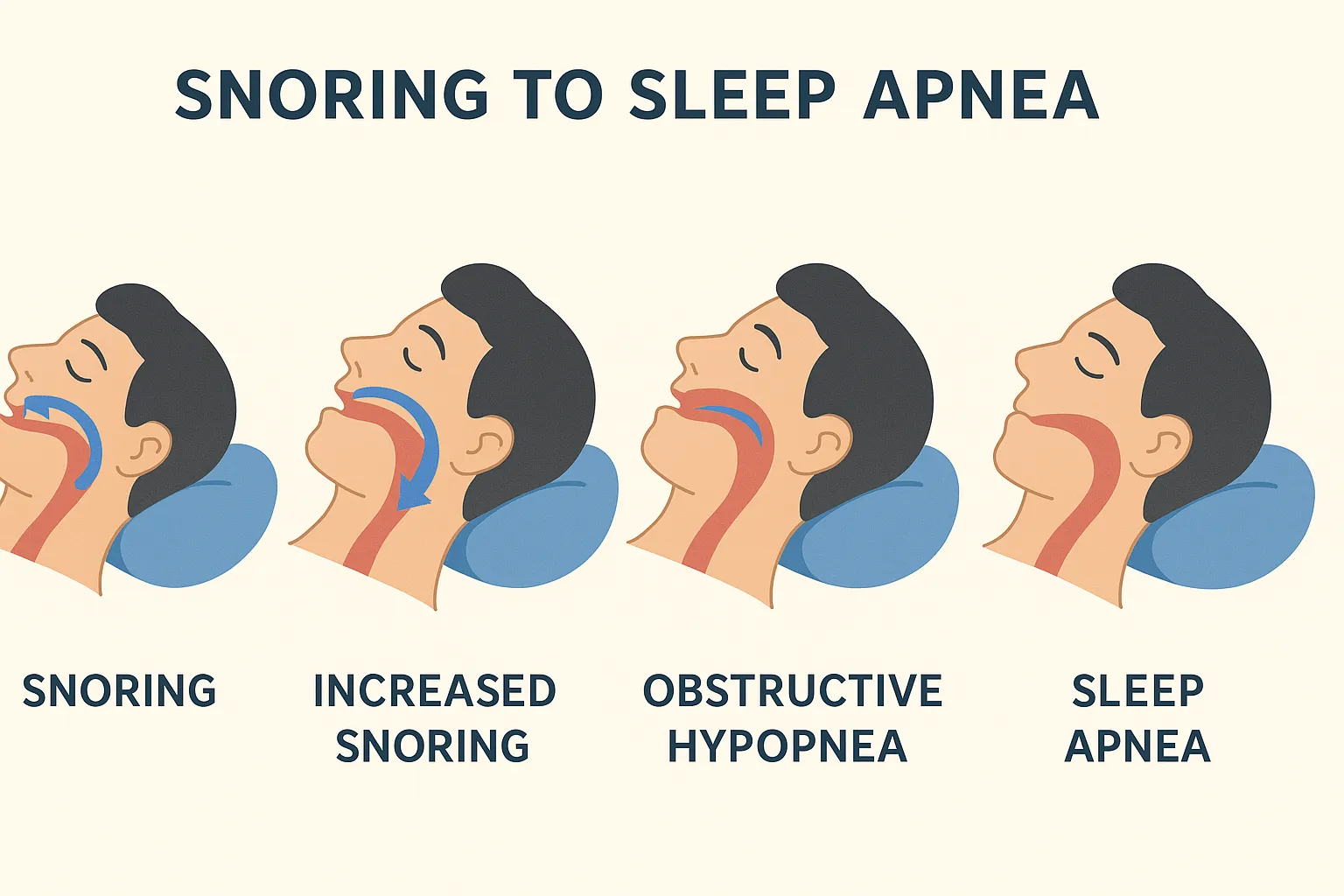From Snoring to Sleep Apnea: Understanding the Progression and Unlocking Natural Relief Through Bioacoustic Therapy
Snoring might seem like a harmless nighttime nuisance, but it can be your body’s first audible cry for help. Often dismissed or laughed off, snoring is frequently the gateway symptom to a more serious condition: obstructive sleep apnea (OSA).
As the airway becomes increasingly compromised, the body’s oxygen levels drop, stress hormones surge, and restorative sleep becomes impossible.If you’ve noticed your snoring worsening over time, wake up tired despite a full night’s sleep, or have been told you stop breathing during the night, you’re not alone — and you don’t have to rely solely on machines or medications.
Welcome to the world of bioacoustic therapy, a revolutionary approach that uses the body’s own vibrational frequencies — detected through the voice — to uncover and correct imbalances. Let’s dive into how this non-invasive tool may help reverse the silent progression from snoring to sleep apnea.
The 4 Stages of Snoring to Sleep Apnea
 1. Mild Snoring – The Early Warning Sign
1. Mild Snoring – The Early Warning Sign
Mild snoring is often caused by a partial blockage in the nasal passages or throat. This might happen from allergies, dehydration, or sleeping on your back. The snoring sound is created by the vibration of relaxed soft tissues in the airway.
What’s Happening:
Airflow is slightly restricted.
Soft palate, uvula, or tongue may be more relaxed than normal.
Usually no drop in oxygen levels or awakenings.
Why It Matters:
Mild snoring often precedes structural or hormonal changes that can worsen over time. Catching it early is key.
2. Moderate to Loud Snoring – Growing Airway Resistance
This stage is marked by deeper, louder, and more frequent snoring. The airway becomes more narrowed, often due to inflammation, poor muscle tone, or fat deposits in the neck or tongue area. Sleep may become fragmented without fully waking the individual.
What’s Happening:
Airway becomes increasingly narrow during sleep.
Tissue vibration is stronger and more disruptive.
Increased likelihood of mouth breathing and dry mouth.
Why It Matters:
This level of snoring is often accompanied by tossing and turning, waking up feeling unrested, and is a precursor to airflow restriction during deeper stages of sleep.
3. Obstructive Hypopnea – Shallow Breathing & Oxygen Drops
Hypopnea is a partial blockage of the airway that results in significant reductions in airflow and blood oxygen levels — but not full cessation. People may still be unaware it’s happening, even though their heart rate and blood pressure are responding to low oxygen.
What’s Happening:
Breathing becomes shallow.
Oxygen saturation drops below 90%.
Micro-arousals or subconscious awakenings occur to restore airflow.
Why It Matters:
Hypopnea is the threshold between snoring and sleep apnea. Cognitive fog, daytime fatigue, and even depression may begin to appear.
4. Obstructive Sleep Apnea (OSA) – Dangerous Interruption
OSA is when the airway becomes completely blocked multiple times throughout the night. These events may last 10 seconds or more and occur dozens to hundreds of times per night.
What’s Happening:
Full or near-complete collapse of the airway.
Oxygen levels plummet.
Brain repeatedly wakes the body to resume breathing.
Heart and nervous system enter survival mode.
Why It Matters:
Untreated OSA is associated with hypertension, stroke, heart disease, memory issues, weight gain, insulin resistance, and even early mortality.
Hidden Hormonal Drivers of Snoring & Sleep Apnea
Behind the physical mechanics of snoring and sleep apnea are hormonal and biochemical imbalances that either cause or worsen the issue.
Common Hormonal Imbalances That Influence Breathing:
| Hormone | Effect on Sleep & Airway Health |
|---|---|
| Cortisol | High stress hormone stiffens muscles and increases inflammation. |
| Thyroid hormones (T3, T4) | Low thyroid slows metabolism and impairs airway muscle tone. |
| Melatonin | Poor sleep hormone production disrupts circadian rhythm and reduces airway muscle relaxation. |
| Leptin | Resistance leads to fat buildup in the neck and weakens respiratory control. |
| Insulin | High insulin levels promote inflammation and fluid retention. |
| Testosterone | Low testosterone is linked to increased apnea in men. |
| Progesterone | In women, low levels decrease upper airway stability. |
How Bioacoustic Therapy Can Help
Bioacoustic Therapy uses voice frequency analysis to detect biomarkers of stress, inflammation, hormone dysfunction, and neuromuscular fatigue — often before symptoms become clinically obvious.
What Is It?
Your voice is recorded and analyzed for frequency anomalies that correspond to key systems of the body.
Specific imbalances (like low oxygen, adrenal stress, or insulin resistance) are mapped.
Targeted frequency sets are then used to help entrain the body back into balance.
How It Supports Snoring and Sleep Apnea:
| Bioacoustic Focus Area | Potential Benefit |
|---|---|
| Airway Muscle Tone | Frequencies support cranial nerve and muscle coordination (tongue, throat, diaphragm). |
| Respiratory Rhythm | Improves synchronization of inhalation/exhalation patterns. |
| Vagus Nerve Activation | Helps regulate breathing, heart rate, and inflammation. |
| Endocrine Support | Helps rebalance cortisol, thyroid, melatonin, and progesterone signals. |
| Weight Regulation | Influences leptin/ghrelin signaling and metabolic performance. |
| Stress Reduction | Targets autonomic nervous system for parasympathetic (rest and repair) dominance. |
The Power of Frequency Repatterning
Each organ, hormone, and muscle in your body operates within a specific frequency range. When stress, toxins, or lifestyle factors push these systems out of tune, symptoms like snoring, fatigue, and apnea arise.
Bioacoustic tools work to “retune” your body, similar to tuning a piano — using sound to encourage balance.
A Natural, Personalized Path Forward
Traditional treatments like CPAP machines or surgeries focus only on managing symptoms — often without exploring the underlying causes. While these can be lifesaving, they don’t correct the root biochemical imbalances driving airway dysfunction.
Bioacoustic Therapy offers a way to:
Address early snoring before it worsens
Improve airway muscle tone and breathing rhythm
Reduce reliance on devices
Balance hormones naturally
Restore deep, restful sleep
Ready to Try Bioacoustic Support for Better Sleep?
If you’re experiencing:
Loud snoring or frequent awakenings
Chronic fatigue or brain fog
Diagnosed sleep apnea and want natural support
A desire to improve hormone balance and sleep quality…
Then bioacoustic therapy may be the solution your body is waiting for.
Take the First Step:
[Schedule a Voice Scan Today]
[Join Our Bioacoustic Sleep Optimization Program]
[Download the Snoring-to-Apnea e-Book]
Your voice holds the key to your health.
Listen closely — and let healing frequencies lead the way.



